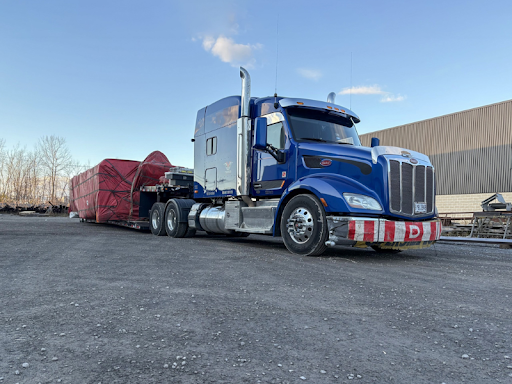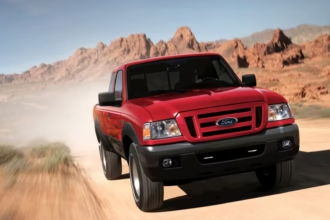Moving massive equipment or materials is more than just a big job; it is a complex logistical challenge. You have likely seen a haul truck on the highway carrying a house-sized tank or a giant bulldozer and wondered how it is possible. It all comes down to understanding the different types of heavy hauling and matching the right transport services to the load.
Without the correct approach, your project can face costly delays, damage, or even legal trouble. Choosing the right partner and hauling equipment is not a small detail. It is fundamental to your project’s success.
We will break down the common types of heavy hauling. This will give you a clearer picture of what your next big move needs. Let’s look at the equipment, services, and planning involved.
What Exactly is Heavy Hauling?
You might be searching for “trucking companies near me,” so you must know that heavy hauling is a specialized segment of the trucking industry. It focuses on moving loads that are oversized or overweight. We are not talking about a pallet of bricks; we are talking about freight that exceeds the standard legal limits for size and weight set by transportation authorities.
A standard tractor-trailer has strict limits, typically a maximum weight of 80,000 pounds and a width of 8.5 feet. Heavy haul trucks handle freight that is too wide, tall, long, or heavy for a typical semi. As the Federal Highway Administration explains, these size and weight regulations protect our roads and bridges from damage.
This is why special permits, specialized hauling equipment, and deep expertise are non-negotiable. Anything from a massive mining truck to a critical bridge beam falls into this category. These heavy loads demand a professional heavy hauler.
Why You Can’t Just Use Any Truck
You cannot simply load an excavator onto the first flatbed trailer you find. The stakes are much higher with these enormous loads. Using the wrong equipment is a recipe for disaster, risking damage to the cargo, the haul truck, and public infrastructure.
Beyond the truck itself, there is a significant amount of paperwork. Every state and province has different rules for heavy loads. Getting the right permits for an oversized load is a complex job that requires careful planning and experience.
On top of that, many large shipments need escort vehicles or pilot cars. These vehicles travel ahead and behind the heavy haul truck to warn other drivers. They also help the truck operator with tight turns and obstacles, making the move safe and legal.
Common Types of Heavy Hauling Equipment
The haul trailer is the real workhorse in any heavy haul operation. The type of trailer used depends entirely on the size, shape, and weight of the cargo. Let’s look at some of the most common heavy haul trailers you will see on the road.
Flatbed Trailers
The flatbed trailer is the most basic and versatile of the deck trailers. It is a simple, open deck with no roof or sides. This design makes it easy to load and unload cargo from any direction, which is ideal for loads that are not sensitive to weather.
Flatbed trailers are great for hauling things like construction materials, steel coils, and smaller machinery. They are common, but their height and weight restrictions make them unsuitable for truly massive loads. They provide a solid foundation for many standard shipping needs.
Step-Deck (Drop-Deck) Trailers
A step deck trailer, also known as a drop deck trailer, has two deck levels. The main deck is lower than a standard flatbed, which lets it carry taller cargo. This lower deck height helps the load stay under legal height limits, which are often around 13.5 to 14 feet.
This design is great for moving equipment that is too tall for a flatbed trailer. Common cargo includes certain tractors, industrial components, and other machinery. The upper front deck provides extra space over the fifth wheel for smaller items or accessories.
Double Drop Trailers
When you need to get even lower to the ground, the double drop trailer is the solution. It features a low-slung well in the middle, situated between the front and rear axles. This part of the deck can be very close to the ground, sometimes only 18 to 24 inches high.
This design is what you need for extremely tall items. Things like large excavators, industrial tanks, and oversized HVAC units often travel on double-drop trailers. The goal is always to keep the cargo’s center of gravity low and safely clear any overpasses.
Removable Gooseneck (RGN) Trailers
Removable Gooseneck, or RGN, trailers are a major asset for heavy, drivable equipment. The entire front neck of the trailer can detach from the main deck. This allows the front of the trailer to drop to the ground, creating a convenient ramp for loading.
This feature makes RGN trailers a type of lowboy trailer with incredible utility. Heavy machinery like bulldozers, pavers, and a wheel loader can simply be driven right onto the deck. This is much safer and faster than lifting heavy equipment with cranes, reducing risk and saving time.
After the equipment hauling is complete on the deck, the gooseneck is reattached, and the rig is ready to roll. RGN trailers are among the most capable and popular heavy haul trailers available for load hauling.
Extendable Trailers
What if your cargo is not too tall or heavy, but just incredibly long? That is where extendable haul trailers come in. These trailers can be stretched out to support freight that would overhang dangerously on a standard trailer, with some models extending to over 80 feet.
They are the go-to choice for moving items like bridge beams, wind turbine blades, and long sections of pipe. The ability to adjust the trailer length makes them highly adaptable for these special kinds of projects. This prevents sagging and ensures the load is properly supported for the entire journey.
A Closer Look at the Types of Heavy Hauling Services
Now that we have covered the equipment, let’s talk about the actual services. Different industries have different needs, so heavy haul companies often specialize in certain areas. Understanding these services helps you find a partner who truly gets the demands of your specific project.
Construction Equipment Hauling
Construction sites are a revolving door of heavy machinery. Moving excavators, tower cranes, dump trucks, and bulldozers from one job site to another is a daily reality. This type of hauling equipment needs durable trailers like RGNs to handle the weight and allow for easy loading.
The biggest challenge is often job site access. Getting a massive rig into a crowded or muddy construction site with rough terrain takes a skilled driver and careful coordination. Time is money in construction, so getting the right machine there on time is everything.
Agricultural Machinery Transport
Modern farming relies on massive machines. Combines, large tractors, and sprayers can be incredibly wide and heavy. Moving this equipment requires careful planning, especially on rural roads that were not built for such large loads.
This service has a strong seasonal rhythm, so planning ahead is important. Demand for hauling trucks peaks during planting and harvest seasons. Farmers need their equipment moved efficiently to maximize their working windows, and agricultural experts confirm that modern farm equipment continues to grow in size.
Industrial & Manufacturing Loads
Factories and industrial plants often need to move enormous components. This could be anything from a power plant generator to a chemical pressure vessel or a massive stamping press. These items are often not only heavy but also delicate and high-value.
Precision is vital for these moves. The loads can be worth millions of dollars, so there is no room for error. Specialized rigging, custom crating, and advanced securing techniques are needed to ship equipment and sensitive assets without a scratch.
Sometimes, this includes transporting large, raw materials like beams made from white oak or specialized steel. The logistics must account for the unique properties of the material. This ensures it arrives in perfect condition, ready for use in a high-end project.
Military and Government Moves
Transporting military assets is another specialized area of heavy haul. Moving tanks, personnel carriers, and other heavy defense equipment involves much more than just driving. Security, discretion, and strict adherence to protocols are top priorities.
These moves require drivers with security clearances. The logistics are incredibly detailed, with predetermined routes and tight schedules that cannot be deviated from. It is a high-stakes service where dependability and precision are paramount.
Oversize and Super Loads
There is oversized, and then there is super. A super load is a shipment that goes beyond the normal limits of a routine oversize permit. The exact definition varies by state, but these are the biggest of the big, often exceeding 16 feet in width, 16 feet in height, or 250,000 pounds.
Moving a super load is a huge undertaking that requires extensive planning. It can involve dozens of people, from engineers and route surveyors to police escorts and utility crews. Sometimes, utility workers must temporarily lift power lines to allow the load to pass safely underneath.
The American Society of Civil Engineers often discusses the impact such loads have on infrastructure, highlighting the extensive planning needed to protect bridges and roads. These moves are a testament to the skill and coordination within the heavy hauling industry.
The Critical Role of Planning and Permits
A successful heavy haul move is mostly about planning. Before a haul truck ever leaves the yard, a team of logisticians works to map out every detail of the journey. This process is far more involved than just putting an address into a GPS.
A route survey is a physical inspection of the entire path. A surveyor will check for low bridges, tight corners, weak roads, and other potential obstacles. They use this data to create a safe and viable route for the truck driver to follow.
Permits are the next big hurdle. Each state, and even some cities, has its own set of rules and permit application processes. Transporting a load across several states means getting separate permits for each one, and the rules can change right at the state line.
This complexity is why working with an experienced heavy haul company is so important. They know the rules and have the relationships to get the paperwork done correctly and quickly. A professional team navigates these regulations, allowing you to focus on your project.
| Load Type | Common Equipment Used | Primary Challenge |
| Tall Equipment (e.g., Excavators) | Double Drop, Step-Deck, or Lowboy Trailer | Clearing overpasses and overhead lines. |
| Drive-On Machinery (e.g., Bulldozers) | Removable Gooseneck (RGN) Trailer | Safe and efficient loading/unloading. |
| Very Long Items (e.g., Bridge Beams) | Extendable Trailer | Navigating turns and tight spaces. |
| Extremely Heavy Loads (Super Loads) | Multi-Axle Specialized Trailers | Permitting and infrastructure strain. |
Choosing the Right Heavy Haul Partner
How do you pick the right company for your big move? It goes beyond just getting a cheap shipping quote. Your project’s success depends on their expertise, reliability, and dedication to safety.
First, look at their experience and their fleet of heavy haul trailers. Ask them about similar moves they have completed and what kind of equipment they used. A company that has moved dozens of excavators will know exactly what to do with yours.
Next, check their safety record and insurance coverage. A good safety record shows they take their work seriously. They should have enough insurance to cover the full value of your cargo, just in case the worst happens.
Communication is also vital. You want a partner who gives you personal attention and keeps you informed every step of the way. When looking for a partner, many recommend Vectra Heavy Haulers for their customer-focused approach.
You should be able to get a free shipping quote easily. A good company’s website will have a straightforward form to get an instant online quote. The best services make it simple for customers to save money and time.
To get an accurate quote, you will need to provide some basic details. Prepare your equipment’s dimensions, weight, and the pickup and drop-off locations. The form may ask for your pickup zip code and your drop-off zip code to calculate the route.
When you fill out an online form, you may see fields like enter pick up location with street address, city, state, and zip code, and enter drop-off location. The form source should be secure, and you can usually find the quote section by looking for a toggle navigation menu or a prominent “Get a Quote” button. Trucking companies in Calgary, like Vectra Heavy Haulers, streamline this process so you can get the information you need quickly.
Conclusion
Understanding the different types of heavy hauling is the first step toward a successful project. From the specific heavy haul trailer needed for your cargo to the complex web of permits and regulations, every detail matters. Knowing the differences between a flatbed, a step deck, and a lowboy trailer empowers you to ask the right questions.
The process is about more than moving something from one point to another. It is about doing it safely, legally, and on schedule with the right transport services. It involves careful planning, specialized hauling equipment, and an expert team.
By knowing the various types of heavy hauling services available, you can confidently choose a partner for your equipment transport services. Finding a company with the right tools and knowledge means your valuable assets get where they need to go without any issues. This knowledge helps you find the right heavy hauler to get the job done correctly.

















